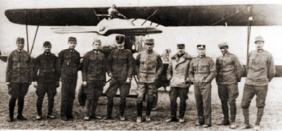


1830 - 1916
March, 1918
1887 - 1922
The Austro-Hungarian Empire struggled against Russia, Serbia, Rumania, Albania, Montenegro and Italy. Luckily, only the Russians and Italians (with allied help) challenged the Austrians in the air. The Austrian air service had begun in 1893 as a balloon corps. Indeed, the balloon was the badge of the Austro-Hungarian Air Service though out the war. In 1912 this corps was re-organized and renamed: der kaiserliche und konigliche Luftfahrtruppen (the Imperial and Royal Aviation Troops), abbreviated as k.u.k. LFT. The Austrians started WWI with a dirigible, 10 observation balloons, 39 aircraft and 85 pilots. The output of the Empire was constrained by lack of industrial strength. This constraint can be demonstrated by production numbers: During the war Austria produced approximately 5000 airframes and 4000 engines. Italy alone produced more than 4 times this number in the three years it was involved in the conflict. Despite the difficulties of the multi-ethnic, multi-language, bureaucratic Empire, its pilots flew and fought with amazing tenacity.
The army air organization was surprisingly streamlined, if not terribly efficient. A front-line combat group was known as a Fliegerkompagnie (Flik) with seven or eight pilots (though on paper it should have as many as 20). By late 1918 there were 82 Fliks. The Fliks were supplied with men by the Fliegeretappenpark (Flep). Material was supplied by the Fliegerersatzkompagnie (Flek). Finally, in 1917 the Fliks were designated by their roles. This role can be determined by the letter appended to the Flik's identification number. These included the Jagdfliegerkampagnie (j, fighter squadron), Photoaufklarerkompagnie (p, photo reconnaissance squadron), Divisionsfliegerkompagnie (d, short-range reconnaissance squadron), Fernaufklarerkompagnie (f, long range reconnaissance squadron), Grossflugzeugkompagnie (g, bomber squadron), Schlachtfliegerkompagnie (s, ground attack squadron), Korpsfliegerkompagnies (k, another short range reconnaissance squadron), and finally, Reihenbildaufklarerkompagnie (Rb, a photo recon unit specializing in serial photography). So, in summary there were Fleks, Fleps and eight different types of Fliks.
The top guns of the k.u.k. army air service always seemed to find themselves in Flik41j. This squad was the first dedicated fighter squad organized in the service and was put under the command of Austria's leading ace, Godwin Brumowski. Brumowski was a friend of, indeed an admirer of, Germany's von Richtofen. He even imitated the Aces of Ace's all red paint scheme on his Alb.D.III. differing only in having a shrouded skull painted on the sides and top decking of the fuselage. Other aces who called 41j home included Linke-Crawford, Gräser, Kaszala, and Gruber. It would seem that visiting and even transferring between units was frequent. Occasionally the ace would take their favorite plane with them. Most of the aces were commissioned officers of the upper strata of society. As in civilian life in the Empire, social standing was strictly delimited and rarely breached even though there were a few NCO aces.
The economic stresses of war brought the Dual Monarchies' ethnic conflicts boiling to the surface in 1918. The young, practical Emperor Karl I clandestinely put out peace feelers to France. France made the communiqué public in an attempt to split the Austro-German alliance. An added result was that non-German ethnic groups in the Empire lost patience with the predominately German bureaucracy. Civil disruptions sundered the empire with ethnic groups declaring independence from the Hapsburgs and the Empire. In a last ditch attempt at reform, Karl renounced power (but not the throne) and supported formation of a republic in Austria. He was eventually driven from his former domains and passed away in Portugal in 1922, still refusing to give up his claims of Austro-Hungarian sovereignty.